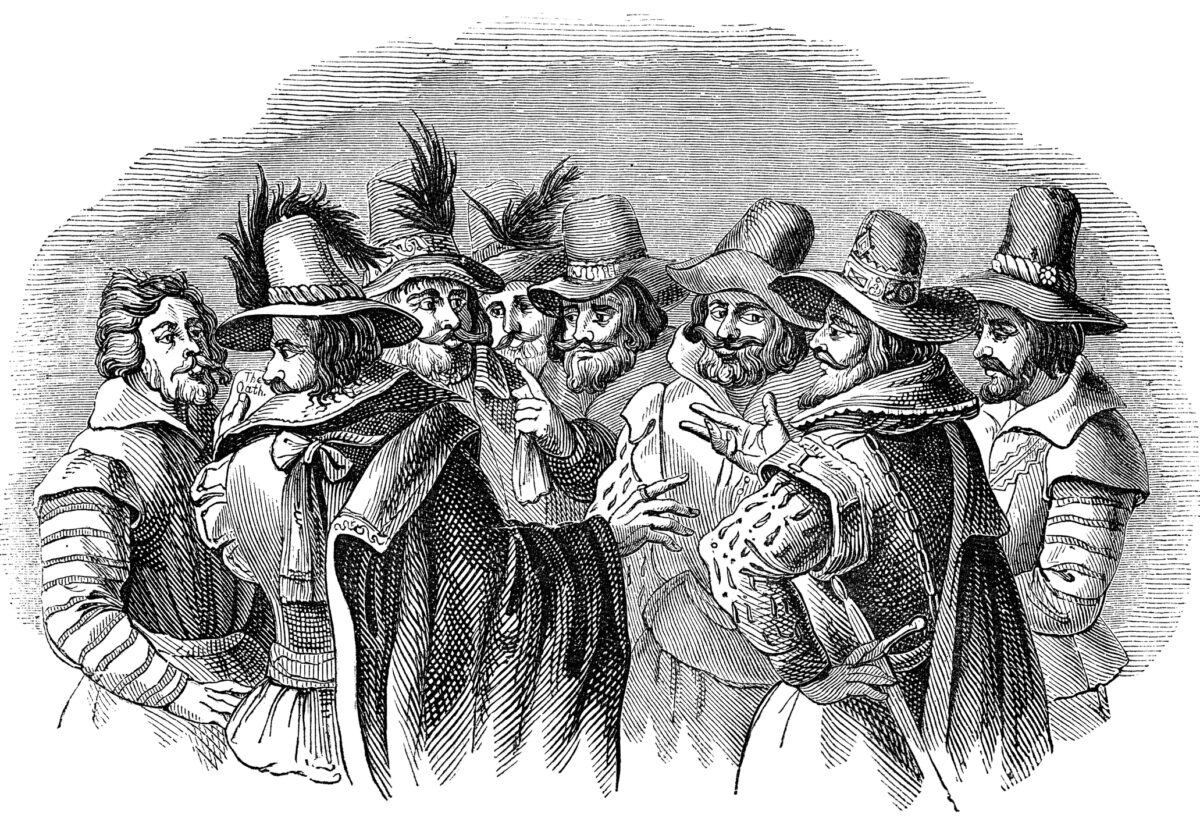 Getty Images/iStockphoto
Getty Images/iStockphotoBritish history is often portrayed as a series of grand kings, noble parliaments, and carefully managed reforms. But underneath that tidy version lies a far more turbulent story—one of uprisings, secret societies, and resistance movements that very nearly changed the course of the nation. From working-class revolts to secret plots against the monarchy, these underground rebellions might not have toppled the establishment, but they certainly rattled it. Here are some lesser-known British rebellions that came surprisingly close to rewriting history.
The Gunpowder Plot (1605)
It’s often remembered as a foiled terrorist plot with a bonfire and a Guy Fawkes mask—but the Gunpowder Plot was nearly much more than that. In 1605, a group of Catholic conspirators led by Robert Catesby, with Guy Fawkes playing a crucial role, plotted to blow up the Houses of Parliament during the State Opening. Their aim? To assassinate King James I and the entire Protestant leadership in one fell swoop.
They rented a cellar beneath the House of Lords and stored 36 barrels of gunpowder—enough to destroy the building and kill everyone inside. The only reason it didn’t succeed was a letter sent anonymously to a member of Parliament. Guy Fawkes was caught red-handed in the early hours of 5 November, tortured, and executed. Had it succeeded, it would have plunged Britain into chaos and possibly civil war.
The Jacobite Rising of 1745
Often romanticised thanks to tartan nostalgia, the 1745 Jacobite Rising was anything but a doomed gesture. Charles Edward Stuart—”Bonnie Prince Charlie”—landed in Scotland and gathered support from Highland clans in an effort to reclaim the British throne for his father, James Francis Edward Stuart. The Jacobites made it as far south as Derby, just 120 miles from London.
Had they continued—and had French support arrived as promised—the balance of power could have shifted dramatically. But after some hesitation and a lack of reinforcements, the Jacobites turned back. Their defeat at the Battle of Culloden in 1746 ended the rebellion, but not before they came alarmingly close to changing the monarchy altogether.
The Pilgrimage of Grace (1536)
In 1536, during Henry VIII’s reign, thousands of people in Northern England took part in the Pilgrimage of Grace—a massive protest against the dissolution of the monasteries, religious reform, and widespread economic hardship. Led by Robert Aske, the rebellion gathered around 40,000 supporters, making it one of the largest uprisings in Tudor England.
They marched under banners bearing the Five Wounds of Christ, framing their movement as a religious defence of traditional Catholicism. Though the rebellion was eventually crushed and Aske was executed, Henry VIII was rattled enough to make temporary concessions and hold back further religious reforms—at least for a while.
The Chartist Movement (1838–1857)
While not a single rebellion, the Chartist movement was an underground political force that sought radical change through collective pressure. Its demands—including votes for all men, secret ballots, and payment for MPs—seemed radical at the time. Massive demonstrations took place across the country, and at its peak, the movement had millions of supporters.
The most dramatic moment came in 1848, when a mass rally on Kennington Common in London led by Feargus O’Connor attempted to present a petition with over 5 million signatures. Fearing revolution, the government deployed troops and mounted police throughout the capital. The movement lost steam soon after, but over time, nearly all of its demands became law. The British Library provides original documents and insights into the movement.
The Pentrich Rising (1817)
Known as the “last armed uprising in England,” the Pentrich Rising was a small but significant rebellion led by working-class men in Derbyshire. Driven by unemployment, hunger, and disillusionment after the Napoleonic Wars, around 300 men armed with makeshift weapons planned to march to Nottingham and then London to spark a national uprising.
What they didn’t know was that their leader, Oliver Brandreth, had been manipulated by a government spy. The movement was swiftly crushed, and several leaders were executed or transported. But the Pentrich Rising exposed the lengths to which Britain’s ruling class would go to suppress even the faintest whiff of revolution.
The Rebecca Riots (1839–1843)
In rural Wales, a movement of tenant farmers took up arms—not against the monarchy or Parliament directly, but against tollgates and corrupt landowners. The Rebecca Riots were led by men dressed in women’s clothing, calling themselves “Rebecca and her daughters.” These cross-dressed vigilantes attacked tollbooths by night, protesting what they saw as unfair taxation and economic exploitation.
The riots were spontaneous and often community-supported, causing such disruption that the government eventually held an inquiry and made reforms to the turnpike system. Though less structured than other uprisings, the Rebecca Riots showed how grassroots rebellion could prompt change.
The Swing Riots (1830)
The Swing Riots erupted across southern and eastern England as rural labourers responded to poor wages, job insecurity, and the introduction of threshing machines, which threatened their employment. Rioters burned hayricks, smashed machinery, and sent threatening letters signed by the fictional “Captain Swing.”
The unrest led to over 2,000 trials, with many participants transported or hanged. While the riots were ultimately crushed, they helped raise awareness of the desperate conditions in the countryside and contributed to future agricultural and political reforms. You can read more in the UK National Archives.
The English Civil War radicals – the Levellers and Diggers (1640s)
During the English Civil War, a number of radical political groups emerged who sought not just to reform England but to reimagine it. The Levellers pushed for universal male suffrage, religious freedom, and legal equality. Meanwhile, the Diggers (also called the True Levellers) began cultivating common land in defiance of property laws, promoting an early form of socialism.
Though both movements were eventually suppressed by Parliamentarian forces, their ideas—particularly those of the Levellers—resonated for centuries. They laid the groundwork for later democratic and socialist thought in Britain.
The United Irishmen Rebellion (1798)
Though it primarily took place in Ireland, the 1798 Rebellion led by the United Irishmen had deep ties to Britain and threatened the union directly. Influenced by the French Revolution and Enlightenment ideals, the United Irishmen sought to establish an independent Irish republic and end British rule. They hoped that uprisings in Ireland would trigger sympathetic revolts in England and Scotland.
The rebellion was brutally suppressed, but its ideology inspired future nationalist movements. The fear it provoked in Westminster also accelerated the eventual Act of Union in 1801. Though unsuccessful militarily, it reshaped British–Irish relations for decades to come.
The Merthyr Rising (1831)
In the industrial town of Merthyr Tydfil in South Wales, years of economic depression and exploitative labour conditions led to open revolt in 1831. Workers seized control of the town, raised a red flag (possibly the first use of one as a symbol of workers’ revolt), and resisted troops for several days.
The uprising ended violently, and one of the leaders, Richard Lewis—known as Dic Penderyn—was executed. The Merthyr Rising became a symbol of early working-class resistance and is still commemorated in Welsh history. It’s a powerful reminder that class tensions simmered well before unionisation was legal or widespread.
Britain may not have had the kind of successful revolutions seen in France or Russia, but it wasn’t for lack of trying. These underground rebellions—some covert, some widespread—revealed deep unrest and a public ready to challenge authority. Though they failed in the moment, many of their ideas and demands eventually made their way into law, shaping the modern UK more than most realise.



